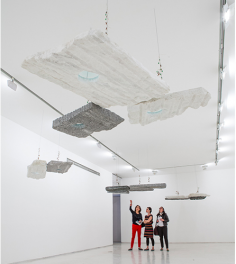Ana Paula Oliveira
Ainda que te vi
source: bamboonet
Instalação, esculturas, fotografias e vídeos compõem a mostra individual de Ana Paula Oliveira, na galeria Millan, em São Paulo. Intitulada “Ainda que te vi”, a exposição traz para dentro dos espaços da galeria crisálidas vivas cultivadas na região do Pantanal. O objetivo é explorar o processo de transformação de substâncias e a tensão entre elementos naturais e seus sistemas de cultivo, pesquisas recorrentes na trajetória da artista. Na instalação, fixadas acima de grandes placas de mármore suspensas por cabos de aço, as crisálidas pairam sobre os visitantes.
O conjunto de esculturas expostas cria um sistema no qual tudo é controlado: da altura das pedras ao grau das lentes de aumento que permitem uma melhor visualização dos animais, até o tempo de eclosão, na qual as crisálidas transmutam-se para belas borboletas. A tensão é latente nos deslocamentos físicos e temporais propostos pela instalação, na expectativa do ápice da metamorfose das crisálidas e nas relações que surgirão entre as borboletas recém-nascidas voando pela galeria e os visitantes da mostra.
.
.
.
.
.
.
.
source: descomplicarte
Quem é que não se encanta diante do processo de transformação de uma lagarta em borboleta? Essa metamorfose presente na natureza e que pode servir de metáfora para vários exemplos na vida foi a inspiração de Ana Paula Oliveira, para criar a exposição ‘Ainda que te vi’, na Galeria Millan.
Assim que li um review da exposição, me senti imensamente atraída para conferir de perto este trabalho. Não conhecia ainda a Galeria Millan e tive uma ótima primeira impressão!
A exposição se divide em fotos, interfaces e vídeos dos casulos se transformando em borboletas, além de uma sala de instalações com casulos verdadeiros pairando sobre a cabeça dos visitantes. Estes foram pendurados em hastes de ferro sobre uma placa de mármore com uma lupa que permite enxergar mais de perto o processo de transformação.
A artista transportou para a galeria 300 crisálidas vivas, que foram cultivadas na região do Pantanal. A crisálida é em si o casulo já formado. Se você tiver sorte poderá presenciar ao vivo o nascimento de uma borboleta e ver algumas voando pela exposição.
Há mini-vídeos mostrando o momento exato em que alguns casulos eclodem e surgem as borboletas recém-nascidas. Em um destes vídeos pude presenciar uma cena de uma borboleta que acabava de sair do casulo e batia num casulo ao lado, como se estivesse chamando à vida, uma de suas companheiras.
.
.
.
.
.
.
.
source: pipaprize
Installation, sculptures, photos and videos comprise Ana Paula Oliveira’s new exhibition, entited “Ainda que te vi”. By transporting live nymphs cultivated in the Pantanal region to Galeria Millan, the artist explores the process of transforming materials and the tension between natural elements and their systems of cultivation, recurrent studies throughout her career.
In the installation, placed on top of large marble plaques suspended by steel cables, the nymphs will hover above the visitors. Magnifying glasses encrusted in the marble serve not only to bring the object closer optically, but also act as interfaces which allow spectators to watch the spectacle of the cocoons hatching. Placed there, between the visitors and the object, they filter and reassign meaning to this phenomenon, already in constant transformation. The set of sculptures create a system in which everything is controlled: from the height of the rocks to the degree of the lens and the time of hatching. In this way, it opposes the natural process in which the caterpillar selects where to settle and depends on conditions of heat and humidity to complete its cycle. This constructed scenario does not imply, however, a lack of conflict. There is a latent tension in the physical and temporal displacements proposed by the installation, in the expectation of the climax of the nymphs’ metamorphosis and in the relationships that will emerge between the recently-born butterflies flying around the galleries and the visitors to the exhibition.
It is precisely in these conflicts that the key of the artist’s production lies, as the art critic Rodrigo Naves commented: “the intelligence of the works consists precisely in placing them in a situation that is foreign to their natural position and, as such, making them more visible, potent and dangerous. And the interesting thing is that, with every new work, Ana Paula succeeds in achieving various meanings, though her procedures do not change radically.”
The show also presents a set of photos of hibernation boxes taken at the SESC Pantanal butterfly vivarium, which highlight the architectural relationship between the structures of the boxes and the nymphs, as well as mini-videos that show the exact moment in which the cocoons hatch and the butterflies prepare to come out into the world.


